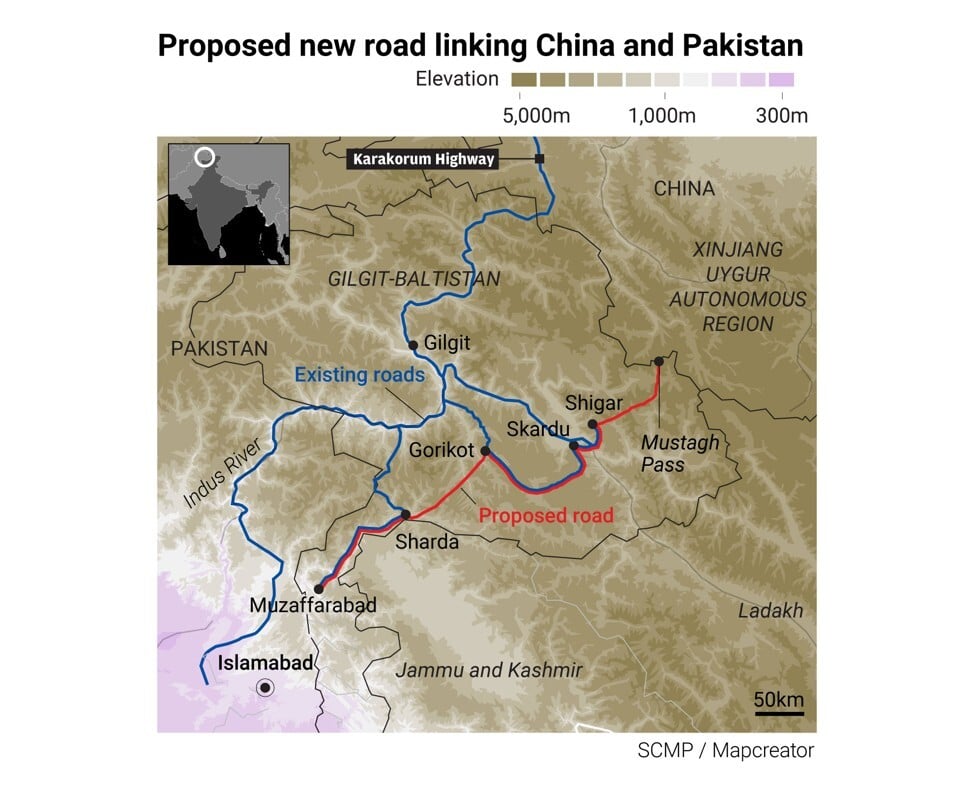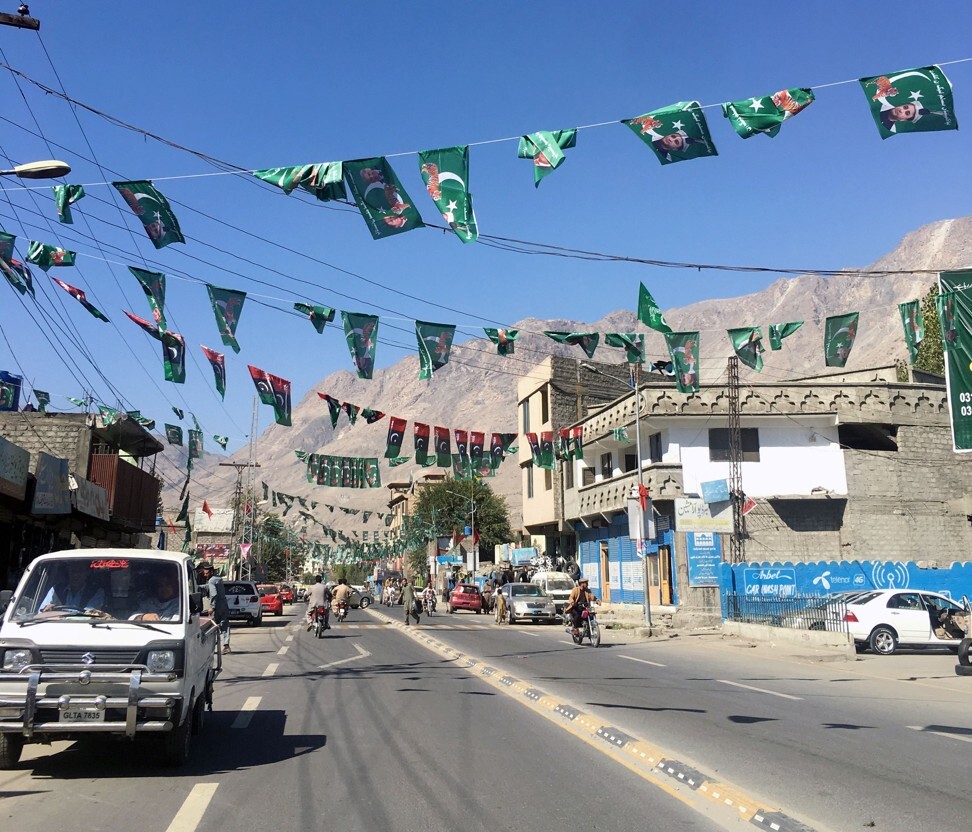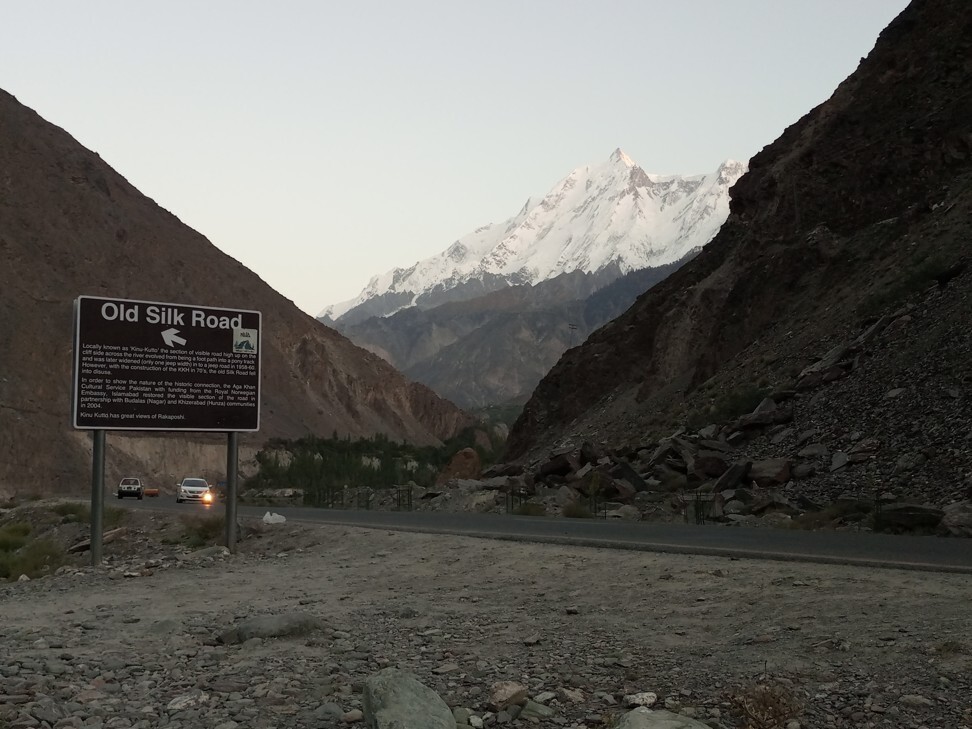Shah_Deu
FULL MEMBER

- Joined
- Jun 7, 2019
- Messages
- 691
- Reaction score
- 0
- Country
- Location
Will a new road between China and Pakistan lead to a military boost against India?
Published: 12:30pm, 31 Jan, 2021

The Khunjerab Pass, along the Karakoram Highway, is the only current crossing between China and Pakistan. Photo: Shutterstock
Pakistan is looking to develop new overland border crossings with China that would potentially boost the allies’ military interoperability against Indian forces in Ladakh and the rest of Kashmir.
Proposals floated this month by the government of the Pakistan-administered Gilgit-Baltistan (GB) region primarily aim to pave the way for a new transit and trade route between China and Pakistan’s neighbours
Afghanistan and Iran.
Currently, China and Pakistan are connected only by the Karakoram Highway, completed in 1978, via a single crossing in the Khunjerab Pass.
However, the route of a proposed new border road from Yarkand – on GB’s border with the
Xinjiang Uygur autonomous region – also suggests strong strategic motivations because it would open a new supply line from China to Pakistani forces deployed along the Line of Control (LOC).
The 740km LOC divides Kashmir roughly into two halves governed by India and Pakistan. Its northernmost point, the India-held Siachen Glacier, is located next to the western extreme of the disputed 3,488km China-India border known as the Line of Actual Control (LAC).
The GB government’s public works department was instructed on January 15 to prepare a “project concept clearance proposal” for a 10-metre-wide road capable of being used by trucks, from the Mustagh Pass on the border with the Xinjiang Uygur autonomous region via the eastern GB region of Skardu, where the Siachen Glacier is located.
The proposed new road would be linked to Yarkand in Xinjiang, and enter GB 126km west of Ladakh, crossing the major supply artery from the Karakoram Highway near Skardu city. From there, it would run south through the high-altitude Deosai Plateau to the Astore Valley, where the southern flank of GB meets the LOC amid the Himalayas.

In a video posted on social media platforms this month, GB chief minister Khalid Khurshid announced plans to drill a road tunnel through the mountains to connect Astore to the Neelum Valley in the Azad Kashmir region, where much of the LOC is thinly demarcated by the Neelum and Jhelum rivers.
ALARM BELLS
Washington-based analyst Sameer Lalwani told This Week In Asia there were potentially three logistics and strategic effects of enhanced China-Pakistan connectivity.
“It could deepen trade links by enhancing transport capacity; enable great Pakistan military mobility in any contingency, threatening India’s hold over the Siachen Glacier; and it can even facilitate greater China-Pakistan military coordination that generates peacetime dilemmas and wartime complications for India,” he said.
The proposed Xinjiang-GB-Kashmir road would “certainly ring alarm bells in New Delhi, which has been acutely sensitive to deepening China-Pakistan strategic and military ties over the past decade”, said Lalwani, who is director of the South Asia programme at the Stimson Center, a Washington-based think tank.
“It may also result in the Indian military – which has already sunk considerable resources to retain control of Siachen – concentrating an even greater proportion of money, manpower, and materiel to its continental defences at the expense of maritime power projection,” he said.

The GB government’s decision to initiate work on the new road between Xinjiang and Kashmir is the latest in a series of developments triggered by New Delhi’s August 2019 decision to rescind India-administered Kashmir’s semi-autonomous status under the Indian constitution.
The move saw the region split into two union territories, Kashmir and Ladakh, fuelling tensions with Pakistan and China, their respective counter-claimants.
Forces from China’s People’s Liberation Army (PLA) subsequently seized 103 square kilometres of India-held territory in Ladakh last year, while Pakistan revised its official map to lay claim to all of Kashmir.
Khan’s Pakistan Tehreek-e-Insaf party won elections held in GB that month, and its new administration there has vowed to embark on a series of development projects aimed at leveraging the region’s position as the cross-border hub for the China-Pakistan Economic Corridor (CPEC).
Since the CPEC’s launch in 2015, some US$28 billion of power generation, motorway and mass transit projects have been built in Pakistan by Chinese state-owned enterprises, ending crippling power shortages and vastly improving its logistical infrastructure.
As part of Beijing’s Belt and Road Initiative, the 15-year CPEC programme was envisioned as a means of integrating the Chinese and Pakistani economies with a view to developing a trade and investment corridor with the Middle East via the Chinese-operated Pakistani port of Gwadar.
‘STRATEGIC OR SECURITY SUPPORT’
Mustafa Hyder, executive director of the Pakistan-China Institute in Islamabad, said “the plan has always been for the CPEC to serve as one corridor with multiple passages”.
“When you talk of the Mustagh Pass or other routes, these are part of the multiple passages which define the CPEC,” he said.
The proposed road from Yarkand to Neelum Valley is part of the historic Silk Road that China has sought to revive under the belt and road plan. Until glaciers blocked the Mustagh Pass in the 1890s, it served as a trade route between Tibet and India.
After much of the Karakoram Highway was upgraded under the CPEC’s first five-year phase, Hyder said “it is only natural that other routes that supplement the Karakoram Highway will come about because the local population and business community of GB foresee a lot of prospective business with China, in which they can be a stakeholder”.
The proposal for the new road was first floated in 2016 during a meeting in Skardu between influential residents and a Chinese delegation.
While conceived as an economic development project, the new China-Pakistan route and other intra-Pakistan connectivity projects “are certainly going to cater to the core interests of Pakistan”, Hyder said.
“If those core interests include strategic or security support to protect Pakistan or China’s sovereignty and security, those roads will certainly be used, if and when need be – and they should be used,” he said.
“The Ladakh stand-off has upped the ante in South Asia. When we talk about the India-China confrontation, particularly post-Ladakh stand-off, the skirmishes between the two sides have alerted neighbouring countries … to the expansionist designs of India, which is being backed by Washington to counter and contain China, and also because of the CPEC, which is seen as a project that needs to be truncated or sabotaged.”
In the video posted online, GB chief minister Khurshid said his administration would also build a westbound highway linking the Karakoram Highway from GB to Chitral, a district of Pakistan’s Khyber Pakhtunkhwa province that straddles the Wakhan Corridor, a sliver of Afghanistan that also borders China and Tajikistan.
The Chinese army has since 2018 stationed troops at a dedicated military base in Tajikistan situated 12km from the corridor, and has conducted joint patrols and counterterrorism operations with Afghan security forces to prevent infiltration by militant Uygur groups.
NATURAL PARTNER
Few members of the separatist Turkestan Islamic Party remain in Afghanistan, after hundreds of militants relocated to Syria following the outbreak of civil war there in 2011 to join al-Qaeda and Islamic State militias that have since been defeated.
In recent CPEC joint working-group meetings, discussions between China and Pakistan have progressed on the development of a highway between Chitral and Chakdara, where it would connect to an existing motorway that culminates near Rashakai, home to the top-priority CPEC special economic zone.
From there, it is a short drive to Peshawar and the Khyber Pass into Afghanistan.
“Afghanistan is a natural partner for Pakistan, so we can see multiple opportunities emerging as the infrastructure improves,” said Hyder of the Pakistan-China Institute.
Likewise, Pakistan is moving ahead with upgrades for the highways connecting Peshawar to Gwadar, as well as two motorways that will complete its nationwide network by 2024.
Pakistan is currently fencing its western border with Afghanistan and Iran, along which it will open dedicated crossings to promote legitimate cross-border trade as a replacement for the large-scale smuggling that has been prevalent along the porous boundaries for decades.

A signboard on the modern-day Karakorum Highway in GB points to a section of the ancient Silk Road connecting China and Pakistan. Photo: Tom Hussain
Michael Kugelman, senior South Asia associate at The Wilson Center in Washington, said both China and Pakistan had powerful economic motivations for pursuing new connectivity projects.
“With China having controlled the pandemic and showing signs of an economic recovery, it has a strong incentive to roll up its sleeves and focus on new infrastructure projects. The idea is to enhance connectivity efforts, but also to better enable China to project power, especially with an eye towards its nearby rival India,” he said.
“For China’s ally Pakistan, which is keen to push back against India and to see the emergence of new infrastructure in a key strategic space, this is just what the doctor ordered – so long as it’s happy with the financing terms of these projects.”
Pakistan expects its deepening alliance with China to figure prominently in forthcoming talks with the newly installed United States administration led by President Joe Biden.
“The first thing we want to talk about is investment partnerships,” Pakistan’s national security adviser Moeed Yusuf said last week at an online event organised by The Wilson Center.
“This conversation about CPEC is not always positive in Washington – how about an American reprocessing zone? How about American companies coming, investing money, reprocessing for export and sending [goods] wherever they want. How about doing things economically where there can be Pakistan-US-China co-investment?”
Yusuf said Pakistan had rejected the idea of being a member of either the American or Chinese camps as the rivals continue to jostle for supremacy.
“It doesn’t make sense for us to say I’m with one and not the other. Neither, frankly, [have] the Chinese ever asked us that, or the US for that matter,” he said.
https://www.scmp.com/week-asia/econ...etween-china-and-pakistan-lead-military-boost
- The Pakistan-administered Gilgit-Baltistan region has proposed a new transit and trade route linking Xinjiang to Kashmir and extending to Afghanistan
- Analysts say this will increase Beijing and Islamabad’s military interoperability against Indian forces in the region, ringing alarm bells in New Delhi
Published: 12:30pm, 31 Jan, 2021

The Khunjerab Pass, along the Karakoram Highway, is the only current crossing between China and Pakistan. Photo: Shutterstock
Pakistan is looking to develop new overland border crossings with China that would potentially boost the allies’ military interoperability against Indian forces in Ladakh and the rest of Kashmir.
Proposals floated this month by the government of the Pakistan-administered Gilgit-Baltistan (GB) region primarily aim to pave the way for a new transit and trade route between China and Pakistan’s neighbours
Afghanistan and Iran.
Currently, China and Pakistan are connected only by the Karakoram Highway, completed in 1978, via a single crossing in the Khunjerab Pass.
However, the route of a proposed new border road from Yarkand – on GB’s border with the
Xinjiang Uygur autonomous region – also suggests strong strategic motivations because it would open a new supply line from China to Pakistani forces deployed along the Line of Control (LOC).
The 740km LOC divides Kashmir roughly into two halves governed by India and Pakistan. Its northernmost point, the India-held Siachen Glacier, is located next to the western extreme of the disputed 3,488km China-India border known as the Line of Actual Control (LAC).
The GB government’s public works department was instructed on January 15 to prepare a “project concept clearance proposal” for a 10-metre-wide road capable of being used by trucks, from the Mustagh Pass on the border with the Xinjiang Uygur autonomous region via the eastern GB region of Skardu, where the Siachen Glacier is located.
The proposed new road would be linked to Yarkand in Xinjiang, and enter GB 126km west of Ladakh, crossing the major supply artery from the Karakoram Highway near Skardu city. From there, it would run south through the high-altitude Deosai Plateau to the Astore Valley, where the southern flank of GB meets the LOC amid the Himalayas.

In a video posted on social media platforms this month, GB chief minister Khalid Khurshid announced plans to drill a road tunnel through the mountains to connect Astore to the Neelum Valley in the Azad Kashmir region, where much of the LOC is thinly demarcated by the Neelum and Jhelum rivers.
ALARM BELLS
Washington-based analyst Sameer Lalwani told This Week In Asia there were potentially three logistics and strategic effects of enhanced China-Pakistan connectivity.
“It could deepen trade links by enhancing transport capacity; enable great Pakistan military mobility in any contingency, threatening India’s hold over the Siachen Glacier; and it can even facilitate greater China-Pakistan military coordination that generates peacetime dilemmas and wartime complications for India,” he said.
The proposed Xinjiang-GB-Kashmir road would “certainly ring alarm bells in New Delhi, which has been acutely sensitive to deepening China-Pakistan strategic and military ties over the past decade”, said Lalwani, who is director of the South Asia programme at the Stimson Center, a Washington-based think tank.
“It may also result in the Indian military – which has already sunk considerable resources to retain control of Siachen – concentrating an even greater proportion of money, manpower, and materiel to its continental defences at the expense of maritime power projection,” he said.

The GB government’s decision to initiate work on the new road between Xinjiang and Kashmir is the latest in a series of developments triggered by New Delhi’s August 2019 decision to rescind India-administered Kashmir’s semi-autonomous status under the Indian constitution.
The move saw the region split into two union territories, Kashmir and Ladakh, fuelling tensions with Pakistan and China, their respective counter-claimants.
Forces from China’s People’s Liberation Army (PLA) subsequently seized 103 square kilometres of India-held territory in Ladakh last year, while Pakistan revised its official map to lay claim to all of Kashmir.
Khan’s Pakistan Tehreek-e-Insaf party won elections held in GB that month, and its new administration there has vowed to embark on a series of development projects aimed at leveraging the region’s position as the cross-border hub for the China-Pakistan Economic Corridor (CPEC).
Since the CPEC’s launch in 2015, some US$28 billion of power generation, motorway and mass transit projects have been built in Pakistan by Chinese state-owned enterprises, ending crippling power shortages and vastly improving its logistical infrastructure.
As part of Beijing’s Belt and Road Initiative, the 15-year CPEC programme was envisioned as a means of integrating the Chinese and Pakistani economies with a view to developing a trade and investment corridor with the Middle East via the Chinese-operated Pakistani port of Gwadar.
‘STRATEGIC OR SECURITY SUPPORT’
Mustafa Hyder, executive director of the Pakistan-China Institute in Islamabad, said “the plan has always been for the CPEC to serve as one corridor with multiple passages”.
“When you talk of the Mustagh Pass or other routes, these are part of the multiple passages which define the CPEC,” he said.
The proposed road from Yarkand to Neelum Valley is part of the historic Silk Road that China has sought to revive under the belt and road plan. Until glaciers blocked the Mustagh Pass in the 1890s, it served as a trade route between Tibet and India.
After much of the Karakoram Highway was upgraded under the CPEC’s first five-year phase, Hyder said “it is only natural that other routes that supplement the Karakoram Highway will come about because the local population and business community of GB foresee a lot of prospective business with China, in which they can be a stakeholder”.
The proposal for the new road was first floated in 2016 during a meeting in Skardu between influential residents and a Chinese delegation.
While conceived as an economic development project, the new China-Pakistan route and other intra-Pakistan connectivity projects “are certainly going to cater to the core interests of Pakistan”, Hyder said.
“If those core interests include strategic or security support to protect Pakistan or China’s sovereignty and security, those roads will certainly be used, if and when need be – and they should be used,” he said.
“The Ladakh stand-off has upped the ante in South Asia. When we talk about the India-China confrontation, particularly post-Ladakh stand-off, the skirmishes between the two sides have alerted neighbouring countries … to the expansionist designs of India, which is being backed by Washington to counter and contain China, and also because of the CPEC, which is seen as a project that needs to be truncated or sabotaged.”
In the video posted online, GB chief minister Khurshid said his administration would also build a westbound highway linking the Karakoram Highway from GB to Chitral, a district of Pakistan’s Khyber Pakhtunkhwa province that straddles the Wakhan Corridor, a sliver of Afghanistan that also borders China and Tajikistan.
The Chinese army has since 2018 stationed troops at a dedicated military base in Tajikistan situated 12km from the corridor, and has conducted joint patrols and counterterrorism operations with Afghan security forces to prevent infiltration by militant Uygur groups.
NATURAL PARTNER
Few members of the separatist Turkestan Islamic Party remain in Afghanistan, after hundreds of militants relocated to Syria following the outbreak of civil war there in 2011 to join al-Qaeda and Islamic State militias that have since been defeated.
In recent CPEC joint working-group meetings, discussions between China and Pakistan have progressed on the development of a highway between Chitral and Chakdara, where it would connect to an existing motorway that culminates near Rashakai, home to the top-priority CPEC special economic zone.
From there, it is a short drive to Peshawar and the Khyber Pass into Afghanistan.
“Afghanistan is a natural partner for Pakistan, so we can see multiple opportunities emerging as the infrastructure improves,” said Hyder of the Pakistan-China Institute.
Likewise, Pakistan is moving ahead with upgrades for the highways connecting Peshawar to Gwadar, as well as two motorways that will complete its nationwide network by 2024.
Pakistan is currently fencing its western border with Afghanistan and Iran, along which it will open dedicated crossings to promote legitimate cross-border trade as a replacement for the large-scale smuggling that has been prevalent along the porous boundaries for decades.

A signboard on the modern-day Karakorum Highway in GB points to a section of the ancient Silk Road connecting China and Pakistan. Photo: Tom Hussain
Michael Kugelman, senior South Asia associate at The Wilson Center in Washington, said both China and Pakistan had powerful economic motivations for pursuing new connectivity projects.
“With China having controlled the pandemic and showing signs of an economic recovery, it has a strong incentive to roll up its sleeves and focus on new infrastructure projects. The idea is to enhance connectivity efforts, but also to better enable China to project power, especially with an eye towards its nearby rival India,” he said.
“For China’s ally Pakistan, which is keen to push back against India and to see the emergence of new infrastructure in a key strategic space, this is just what the doctor ordered – so long as it’s happy with the financing terms of these projects.”
Pakistan expects its deepening alliance with China to figure prominently in forthcoming talks with the newly installed United States administration led by President Joe Biden.
“The first thing we want to talk about is investment partnerships,” Pakistan’s national security adviser Moeed Yusuf said last week at an online event organised by The Wilson Center.
“This conversation about CPEC is not always positive in Washington – how about an American reprocessing zone? How about American companies coming, investing money, reprocessing for export and sending [goods] wherever they want. How about doing things economically where there can be Pakistan-US-China co-investment?”
Yusuf said Pakistan had rejected the idea of being a member of either the American or Chinese camps as the rivals continue to jostle for supremacy.
“It doesn’t make sense for us to say I’m with one and not the other. Neither, frankly, [have] the Chinese ever asked us that, or the US for that matter,” he said.
https://www.scmp.com/week-asia/econ...etween-china-and-pakistan-lead-military-boost






 . Pakistan Zindabad
. Pakistan Zindabad


